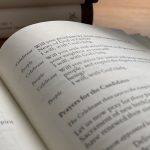Article by Peter Koeppel, member of Trinity Memorial Church in Binghamton and the diocesan Stewardship Resources team.
It’s been a long time: I had recently hooked up with a local public-arts studio, which had equipment they would rent out to local artists for their work. One of my hobbies led me to them, and I became good friends with them. Except—whenever the owner of the studio approached me, the hair on the back of my neck would bristle. But I noticed that my reaction to the young man, slightly older than myself, was apparently not shared by anybody else. I could not, for a while, figure out why my reaction to his physical presence should be so different from everybody else’s. Until it dawned on me: his body language was different. What to him was an open, inviting body language, to me, having grown up in a socially more formal environment, looked like a threatening move. Pierre, you see, was from the Caribbean. I’m not. And my body and mind, having learnt one particular body language, completely misread his and reacted accordingly.
So, I undertook learning a new body language. I didn’t have to learn to speak it; it was sufficient for me to learn to read Pierre’s body language as automatically as the body language I learned to speak and read growing up. And Pierre and I became very good friends. Just as it should be.
How many times do we look at somebody with concern, suspicion, fear, or outright rejection, because they move differently than we ourselves do, dress differently than we ourselves do, or have a skin color different from our own? How many times, before it is too many?


